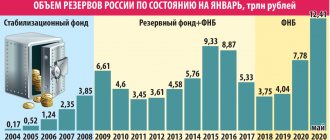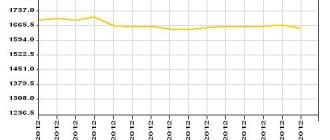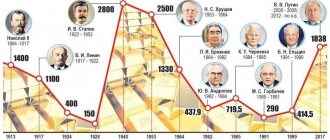What is the World Gold Council
The World Gold Council was created to develop the market in the gold mining industry. The organization itself sees its goal as stimulating and maintaining demand for gold, providing leadership in the industry and being the global authority on the gold market.
In other words, the World Gold Council was formed to lobby the interests of its members, research the market situation, conduct active marketing policies in support of its constituent companies and manipulate supply and demand in the gold market. The organization's head office is located in London. From here, approximately 3/4 of the world's gold turnover is controlled.
The World Gold Council is committed to boosting consumption. Its task is to protect, maintain and increase the existing demand for the precious metal for the further development of the industry. To this end, the structure allocates funds for monitoring markets, research programs in the field of promoting gold-containing products and searching for new areas of application for the precious metal. This direction of the World Gold Council's activities has already made it possible to obtain metal with a purity above 99%.
Historians believe that gold was first smelted and used as a precious metal back in the 37th century BC in Ancient Egypt. Reaching this quality to the present day, today it is used for the production of jewelry, medical equipment, electronics, and is also used as an effective investment tool.
According to the World Gold Council, the greatest volume of production of the yellow metal occurred in the period after World War II and modern times. Today, the development of precious metal deposits is carried out everywhere on the planet, with the exception of Antarctica. With each new decade, the number of gold-mining countries is growing. Therefore, production no longer has such a narrow local concentration as in the past and is evenly distributed throughout the world. Gold mining is active in Peru, China, South Africa, Australia, Canada, Russia and the United States of America.
The attractiveness of gold is due to both its commercial properties and investment use. The minimal demand for the yellow metal is supported by its use in dentistry, the electronics industry and jewelry. This is a non-financial area. The rest of the demand is provided by large and small investors who see gold as a reliable asset that can protect savings and capital from inflation and economic crises.
Gold cannot be counterfeited. Its reserves on earth and in its depths are limited. And the depreciation of the precious metal can only be caused by a sharp increase in mined volumes, which was practically not observed.
The World Gold Council has initiated the emergence of structures such as gold exchange-traded funds (ETFs). The essence of their activity is to issue securities for the stock market, the profitability of which depends on the quotes of index funds, certain categories of assets, bonds and commodity indices. The securities of gold exchange-traded funds are traded like traditional stocks. The attractiveness of this alternative investment method for individual investors is due to the fact that ETFs are superior to mutual fund securities in terms of daily liquidity and are not burdened with high commissions. All ETF price volatility is contained within the daily trading session. And asset management is carried out by professional traders, which increases investment efficiency.
How will the pandemic change demand for gold?
The global coronavirus pandemic has already had a significant impact on the price of gold - the value of the metal has risen sharply and reached record highs in many currencies. At the same time, the demand for gold has changed in different ways around the world. Thus, it increased significantly in Western markets, decreased in Asia, and remained virtually unchanged in Russia, Tatyana Fitz reported to TASS.
“It is difficult to predict what the data for the third quarter will show. However, judging by the results of a study of Russians’ attitudes towards gold, interest in investing in gold may have increased during the pandemic. People turn to gold during crises, and this also applies to the current economic conditions. It is not yet clear how serious the second wave of the pandemic will be, so investors will likely seek to avoid risks,” notes the WGC Director of Public Policy.
The pandemic could affect people's long-term attitudes towards gold, the expert believes. Russia is now looking to improve financial literacy and develop a retail investment market with a focus on long-term savings and pensions.
“Amid the pandemic, consumers may want to learn more about how to best manage their long-term savings. Research shows that gold is an important part of savers' and investors' long-term portfolios,” Fitz concluded.
For responsible investing
Photo: Vlad Nekrasov, Kommersant
Photo: Vlad Nekrasov, Kommersant
A survey of central banks revealed growing regulatory interest in alternative investments that meet sustainability requirements - ESG. Sustainable bonds were the most popular asset class, with nearly half of WGC survey respondents saying they would increase their positions in these assets. These data suggest that ESG continues to receive significant attention, especially from central banks in advanced economies. According to Shaokai Feng, there is growing recognition of both the importance of ESG investing in achieving public policy goals in this area, and the role that central banks can play in raising awareness on the issue.
ESG bonds from quality issuers may be a suitable tool for building central bank reserves, analysts say. Firstly, if a company meets the requirements of sustainable development, then it automatically has a larger number of investors, which is positive for its price. According to the executive director of VTB Capital Investments, senior vice president of VTB Vladimir Potapov, in the world in general and especially in Europe, a significant part of institutional investors pay great attention to environmental aspects, corporate culture, and attitude towards employees. Secondly, worldwide control over the activities of companies is growing in terms of various risks and the impact of these companies on the environment. “This is becoming a serious risk, which can materialize in fines, which leads to a decrease in company profits and share prices,” notes Vladimir Potapov.
Central banks of developed countries are actively involved in the transformation to a green economy and stimulate demand for green financing instruments, including by purchasing them for reserves, says Anna Kuznetsova, Deputy Chairman of the Board of Rosselkhozbank. “The purchase of ESG bonds by the Bank of Russia to form reserves could be a good incentive for the development of the Russian ESG financing market,” says Ms. Kuznetsova.
Why do the Central Banks love gold?
Central banks remain positive on gold. This is evidenced by the annual survey of financial regulators conducted by the WGC. The study was conducted between February 17 and April 19, 2021. 56 central banks took part in the survey. At the same time, 36% are from countries with developed economies, and 64% are from countries with emerging markets and developing economies. The survey showed that 21% of regulators intend to increase their gold reserves in the next 12 months. No bank plans to cut reserves this year versus 4% previously. Another 68% do not plan to change their gold holdings. Only 11% of respondents were undecided about plans for gold this year, compared to 20% last year. “Central banks, as systemically important financial institutions, are obliged to pursue conservative policies and ensure the integrity and stable operation of the foreign exchange markets and financial systems of their countries. Therefore, of course, they cannot keep the bulk of their foreign exchange reserves in gold: transactions with it are more complex than foreign exchange transactions and can lead to increased volatility in the markets. But the trend itself towards increasing the share of gold by central banks, in our opinion, is completely justified and is of a long-term nature,” says Evgeny Loktyukhov.
There is no place for Bitcoin
Last year, many institutional investors and global brokers bet on another asset, Bitcoin, which was rising in value at a record pace. In such conditions, some investment banks began to wonder whether digital currency could become an alternative to gold. The cryptocurrency was favored by the limited supply of Bitcoin, good liquidity (daily turnover reached $30–50 billion), high capitalization, which exceeded $1 trillion, as well as protection from the growth of the world’s money supply.
Despite growing excitement among some investors, central banks have not announced plans to invest in cryptocurrencies. “Gold and cryptocurrencies are fundamentally different asset classes. “Cryptocurrencies do not meet the investment criteria of central banks’ reserves, such as safety, liquidity and profitability,” says Shaokai Feng. Bitcoin and gold have more differences than similarities, and they serve different functions, WGC representatives note. “For example, the prices of Bitcoin and gold are not highly correlated, which is one reason why an investor who is hoping to benefit from the high growth potential of cryptocurrencies may be more inclined to also invest in gold to hedge against the high volatility of cryptocurrencies,” highlights Director of Public Policy and Interaction with Central Banks WGC Tatyana Fitz.
The spring of this year showed that digital currencies are still considered very risky assets and therefore cannot be included in the gold and foreign exchange reserves of the Central Bank. After growing fourfold last year and reaching a new all-time high of $65,000 in April of this year, the digital currency began to decline rapidly in May. On June 29, the bitcoin rate fell below $30 thousand for the first time since the beginning of the year. According to the general director of Sputnik Capital Management, Alexander Losev, against the background of the growth of the money supply in the world, investors bought various assets, including speculative ones, but rising inflation will force the central banks will begin tightening monetary policy, and once this begins to happen, speculative assets or pseudo-assets, such as crypto, will be the first to pour in.
Vasily Sinyaev
Metal sellers
The Central Banks of the Philippines and Turkey acted against the trend, selling 24.7 and 18.1 tons of metal respectively since the beginning of the year. As a result, the volume of gold in the reserves of these countries amounted to 164.1 tons and 526 tons, respectively. Some countries with emerging markets have faced a deterioration in their balance of payments during the pandemic, therefore, according to the head of the analytical department of the Region Group of Companies, Valery Weisberg, they are forced to reduce investments in metal. “Last year, the Central Bank of the Philippines decided to maintain the share of gold in international reserves at the level of 10% and therefore, with a strong increase in quotations, it does not buy, but sells gold,” notes Valery Weisberg.
The Central Bank of Turkey is forced to sell liquid parts of gold and foreign exchange reserves (including gold) amid enormous pressure on the national currency. Since the beginning of the year, the Turkish lira has fallen by almost 20%, to 8.3 lira per US dollar. “The depreciation of the Turkish lira is largely due to a lack of foreign exchange earnings amid a decrease in investor appetite for Turkish assets and a collapse in tourism. Selling gold reserves for foreign currency is a way to plug this hole,” explains Georgiy Okromchedlishvili, head of the analytical department of the personal banking department of Zenit Bank.
The Russian Central Bank, which until recently was the largest buyer of the metal, also sold gold. The Bank of Russia has been most active in purchasing the precious metal since 2014, when, amid the expansion of anti-Russian sanctions, it was forced to reduce the share of dollar assets in its reserves. By 2021, the financial regulator acquired 1,236 tons of gold, more than doubling its volume in reserves. However, starting from the second quarter of last year, the Central Bank stopped purchasing metal; moreover, in the second half of 2021, it reduced the amount of gold in its reserves by 1.3 tons. From January to April 2021, the regulator has already sold 6.2 tons, and metal reserves have dropped to 2292.3 tons. However, the decrease in the volume of gold in Russian reserves is associated not so much with sales of the metal, but with the issue of investment and commemorative coins. This year, up to 800 thousand pieces of “St. George the Victorious” coins alone are planned to be issued in different denominations, which will require 9 tons of gold.
Countries with the largest gold and foreign exchange reserves
| 3357,02 | 118,24 | |
| Japan | 1390,72 | 46,44 |
| Switzerland | 1083,29 | 63,12 |
| USA | 627,45 | 493,61 |
| Russia | 596,51 | 139,49 |
| India | 590,15 | 41,06 |
| Taiwan | 555,62 | 25,71 |
| Hong Kong | 491,78 | 0,13 |
| Saudi Arabia | 472,81 | 19,61 |
| South Korea | 443,45 | 6,34 |
| Singapore | 369,82 | 7,73 |
| Brazil | 355,61 | 4,09 |
| Germany | 268,03 | 204,06 |
| Thailand | 258,09 | 9,34 |
| France | 223,96 | 147,85 |
| Italy | 210,41 | 148,80 |
| Mexico | 199,06 | 7,29 |
| Great Britain | 180,02 | 18,83 |
| Czech | 166,12 | 0,58 |
| Poland | 154,19 | 13,88 |
| Indonesia | 135,91 | 4,77 |
| Philippines | 109,97 | 11,46 |
| Malaysia | 107,64 | 2,36 |
| United Arab Emirates | 106,70 | 3,50 |
| Canada | 90,43 | 5,12 |
| Türkiye | 82,98 | 33,03 |
| Spain | 81,26 | 17,09 |
| Libya | 80,71 | 7,08 |
| Norway | 75,26 | |
| Denmark | 72,82 | 4,04 |
| Peru | 68,12 | 2,10 |
| Iraq | 65,33 | 5,85 |
| Algeria | 59,41 | 10,53 |
| Colombia | 58,50 | 0,25 |
| Sweden | 58,25 | 7,63 |
| South Africa | 54,99 | 7,61 |
| Kuwait | 52,91 | 4,79 |
| Romania | 52,18 | 6,29 |
| Australia | 44,47 | 4,85 |
| Bangladesh | 43,17 | 0,85 |
| Hungary | 41,35 | 1,91 |
| Qatar | 40,97 | 3,44 |
| Chile | 39,17 | 0,01 |
Source: WGC
Geopolitical component of reserves
Russia was one of the first to refuse part of its investments in US dollars. On July 5, the National Welfare Fund (NWF) officially reduced the share of the dollar to zero, the share of the Japanese yen was 4.7%, the share of the pound sterling was reduced to 5%, and the euro and yuan were increased to 39.7% and 30.4%, respectively. For the first time, the fund’s structure included gold (20.2%).
However, the head of the Central Bank of Russia, Elvira Nabiullina, previously announced that the dollar will remain part of Russia’s international reserves. “When we consider the structure of our reserves, we, of course, take into account not only economic factors, the profitability of reserves, the degree of liquidity, but also geopolitical risks. But we believe that dollars will remain part of our reserves,” Ms. Nabiullina said in an interview with Bloomberg. According to her, the regulator is pursuing a policy to reduce the economy’s dependence on all foreign currencies.
The decision of the Ministry of Finance to reduce the share of the dollar in the National Welfare Fund is caused by the desire to ensure the safety of the sovereign fund in light of high sanctions risks. After the tightening of US sanctions against the primary ruble public debt and the continuing threats to the operations of the government/state banks and state-owned companies in US dollars, this is an option that remains available to the American authorities even within the framework of the current sanctions legislation, says Dmitry Polevoy, Investment Director of Loko-Invest. “The Ministry of Finance is consistently diversifying its investment portfolio, thereby reducing dependence on one currency. Avoiding the dollar when investing in the National Welfare Fund will reduce geopolitical risks and allow you to preserve investments for future generations,” notes Mikhail Vasiliev.
Dollar vs Yuan
Central banks had mixed views on the future position of the US dollar in reserves. According to the survey, 50% of the Central Banks said that in five years the US currency will occupy a smaller share of reserves than it does now. According to Sovcombank chief analyst Mikhail Vasiliev, reliability is one of the main factors when placing international reserves. Therefore, the increase in the geopolitical premium in dollar reserves has reduced their attractiveness for a number of countries. “There was also a sharp increase in the dollar money supply in 2021 - the M2 indicator in the United States increased by 25%, which led to the depreciation of the dollar against major currencies,” notes Mr. Vasiliev.











